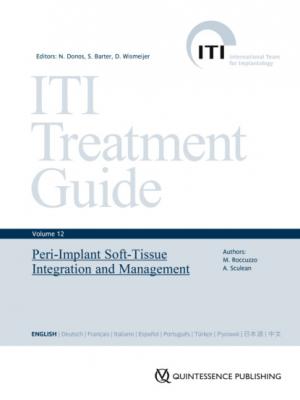Peri‑Implant Soft‑Tissue Integration and Management. Mario Roccuzzo
Чтение книги онлайн.
Читать онлайн книгу Peri‑Implant Soft‑Tissue Integration and Management - Mario Roccuzzo страница 4
 Tissue-Level Implants
Tissue-Level Implants
3.1 Soft-Tissue Management at Implant Placement
3.2 Soft-Tissue Management Before Implant Placement
3.3 Soft-Tissue Management During Supportive Care
4 Soft-Tissue Grafting After Implant Placement
4.1 Increasing the Width of the Keratinized Mucosa
4.2 Soft-tissue Replacement Materials
A. Sculean
5 Peri-Implant Soft-Tissue Dehiscences
5.1 Indications for Peri-Implant Soft-Tissue Dehiscence Coverage
M. Roccuzzo
5.2 Techniques for Treating Peri-Implant Soft-Tissue Dehiscences
M. Roccuzzo
5.2.1 Tunneling Technique for Treating Peri-Implant Soft-Tissue Dehiscences
A. Sculean
6 Clinical Case Presentations
6.1 Implant Placement in the Esthetic Zone and Coverage of Multiple Gingival Recessions
S. Aroca
6.2 Periodontal Plastic Surgery and Prosthetic Procedures to Treat Peri-Implant Soft-Tissue Dehiscences
P. Casentini
6.3 GBR and Soft-Tissue Augmentation Following Explantation to Rehabilitate a Soft- and Hard-Tissue Defect
R. Cavalcanti, P. Venezia
6.4 Soft-Tissue Volume Augmentation Using a Connective-Tissue Graft Harvested from the Maxillary Tuberosity
D. Etienne
6.5 Connective-Tissue Graft to Increase the Width of the Keratinized Mucosa Around an Osseointegrated Implant
V. Iorio-Siciliano
6.6 Soft- and Hard-Tissue Regeneration and Implant-Supported Restorations to Treat a Complex Anterior Maxillary Case
R. Jung, A. Gil, C. Hämmerle, D. Thoma
6.7 Early Implant Placement, Contour Augmentation, and Autologous Connective-Tissue Graft Using a Tunneling Technique to Replace an Upper Incisor with Generalized Gingival Recession
E. Lorenzana, J. Gillespie
6.8 Connective-Tissue Graft to Augment the Buccal Tissue for a Bone-Level Implant at an Upper Incisor Site
E. Lorenzana, K. Riewe
6.9 Treatment of a Soft-Tissue Fenestration in the Esthetic Zone
N. MacBeth, N. Donos
6.10 Covering a Soft-Tissue Dehiscence at a Mandibular Incisor
M. Roccuzzo
6.11 Soft-Tissue Augmentation Using a Porcine-Derived Collagen Matrix to Correct a Labial Soft-Tissue Defect Following Extraction of a Maxillary Incisor
S. Shahdad
7 Conclusions
M. Roccuzzo
8 References
In the earlier days of implant dentistry, osseointegration was considered to be a sufficient condition for long-term successful implant rehabilitation. With time, however, it became evident that soft-tissue integration is of significant importance and that the formation of an early and long-standing effective mucosal barrier, capable of biologically protecting the peri-implant structures, is essential. This soft-tissue barrier is mainly the result of a wound-healing process that results in an effective interface between “living tissues” and a “foreign body” (Rompen and coworkers 2006).
Whether the presence of a minimum amount of keratinized mucosal (KM) is necessary for the long-term maintenance of peri-implant health has been controversial for many years. Several researchers have found that insufficient KM may be correlated with plaque accumulation, bleeding on probing, discomfort when brushing, mucosal recession, and peri-implant mucositis (Bouri and coworkers 2008; Boynueğri and coworkers 2013; Chung and coworkers 2006; Roccuzzo and coworkers 2016). Other researchers were unable to obtain similar findings (Frisch and coworkers 2015), with some even suggesting that KM may not be essential in the presence of scrupulous oral hygiene and rigorous compliance with a professional maintenance regimen (Lim and coworkers 2019).
On the other hand, complete osseointegration and perfect soft-tissue integration are not necessarily correlated with successful esthetic rehabilitation of a missing tooth or teeth. Indeed, success criteria for esthetically sensitive areas must include measurements of the peri-implant mucosa, as well as the restoration and its relationship to the surrounding dentition (Belser and coworkers 2004).
Apart from the prosthetic aspects, sufficient horizontal and vertical volume is also essential for long-term esthetic soft-tissue stability. Where soft-tissue deficiencies exist, appropriate augmentation procedures may be required for comprehensive rehabilitation. Recent advances in implant dentistry have provided clinicians with various treatment options to treat peri-implant soft-tissue defects. At the same time, though, soft-tissue grafting procedures are of moderate to high complexity and may be associated with a significant risk of complications. For this reason, various step-by-step procedures have been outlined and illustrated by individual case descriptions for the reader of this book.
The aim of this ITI Treatment Guide is to foster awareness of the increasing demands on clinicians to provide treatment for a growing population of patients with soft-tissue related problems. The authors hope that Volume 12 will be a valuable resource and reference work for the treatment of patients with mucogingival deformities to reduce the risk of biological and esthetic complications and to ensure predictable and stable long-term